Beyond the Brush: Inventive Use of Media for Painting Students
Concluding Updated on February 8, 2017
This commodity outlines unusual painting and drawing techniques that are useful for creating exciting sketchbook pages, grounds, textural layers and calculation tone and colour to an artwork. While mastery of traditional painting techniques tin can exist all that is needed in a loftier school art project, sometimes combining traditional methods with wild and inventive approaches is advantageous!

Dip paper directly into pigment / ink
Splashing liquid paint or dye onto a surface is 1 of the most unpredictable and exciting ways of applying colour. Accept turns at the classroom sink, dipping whole sheets of paper into watered downward acrylic, splashing and flicking water across your work: holding newspaper, sail or other painting surfaces in the air and letting the pigment run down. Once an appealing wash of colour has been achieved, placed the artwork apartment to dry, so the paint or ink pools and dries in naturally occuring swirls.
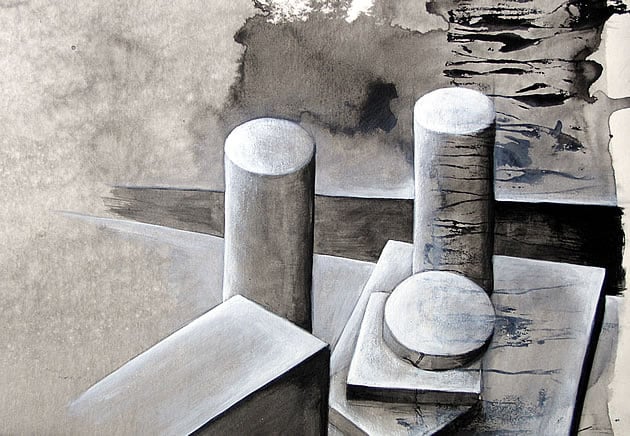
Paint using drips
Gravity can be a superb painting tool. Working with thicker, yet still runny pigment (the consistency of business firm pigment is ideal) long splashes and drips of paint can be controlled through tipping and altering the direction of a canvas, or through flicking paint wildly at a work in the fashion of Jackson Pollock (photographed by Hans Namuth) below.
There was complete silence … Pollock looked at the painting. And so, unexpectedly, he picked upwards can and paint brush and started to motility effectually the canvass. Information technology was as if he all of a sudden realised the painting was not finished. His movements, slow at outset, gradually became faster and more dance like equally he flung black, white, and rust colored pigment onto the canvas – Hans Namuth.

Using only gravity and a rotating sheet (and sometimes string equally a guide) Canadian artist Amy Shackleton creates vibrant, complex scenes that are formed entirely from drips of paint squeezed from a canteen :
Paint with your torso
Students should never be agape of mess. Embracing the concrete deed of painting (removing the purlieus betwixt the maker and the artwork) allows you to 'get i' with an artwork. Get rid of your school uniform and dress yourself in quondam painting clothes. Spread a big plastic sheet in the corner of your art room (or go outside) and apply paint using your easily your anxiety or any function of your torso that you dare! (Note: wash yourself thoroughly afterwards so as non to enrage head teachers or senior management)!
Painting with hair past Lilibeth Cuenca Rasmussen:
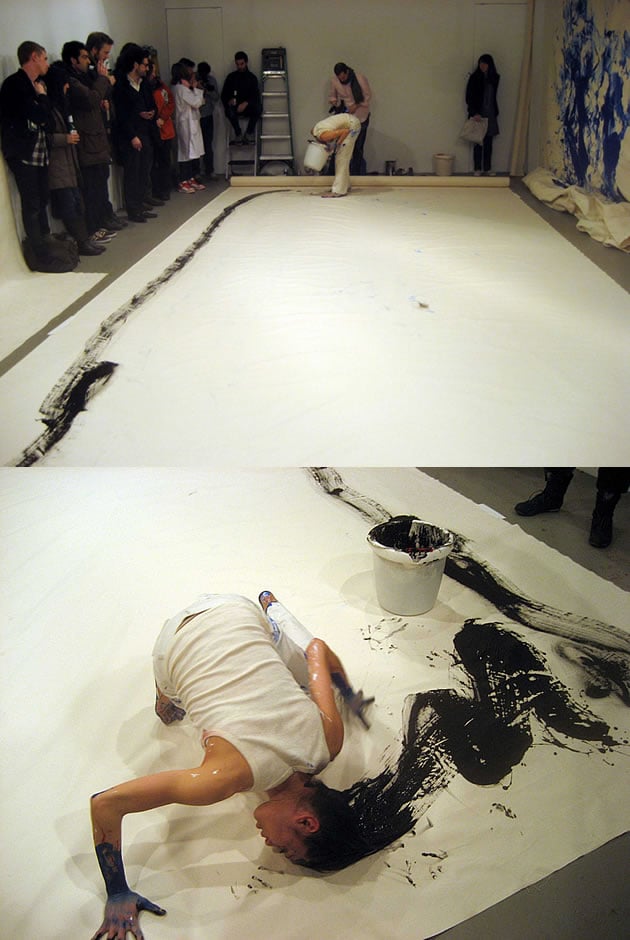
Painting with feet by Kazuo Shiraga:

Draw using utensils tied to a stick
Just equally removing the boundary betwixt the maker and the creation can result in exciting outcomes, so too tin exaggerating the gap between the artist and the piece of work. Here we come across exciting, gestural drawings past Yr x students from Bolton School (Girls' Partition):

Smear paint with a rag
Most students will wipe paint off their work at some point – normally when fearing they have made an mistake. Michael Shapcott does this with a magical beauty: using a rag to spread paint across his canvas until the right intensity is achieved. Offset with a detailed graphite nether-cartoon, he applies oil and acrylic pigment over the top and then wipes most of it away. Watching him piece of work is entrancing:
Employ pigment with menu
An alternative to applying pigment with a palette knife is to use the flat border of a piece of paper-thin. This is a cheaper and much more attainable strategy for a high school fine art student. Able to be cut, bent or folded as required, card is a smashing material for applying flat areas of color to a work.
An example of painting with card by artist Mike Bernard:

Paint with a roller
Near students have used a roller to use press ink; fewer experiment with using a roller every bit tool to employ colour to their paintings. Although acrylic paint doesn't roll out likewise as press ink (it doesn't spread easily and covers surfaces in an irregular, unpredictable manner) it is withal a great manner of achieving layers of flat tone in an artwork.
An example of painting a sketchbook page groundwork with a roller by Julie Fei-Fan Balzer:

Squash blobs of paint flat with a piece of paper
A less controllable method of achieving areas of flat tone in a work is to press paper in blobs of pigment and use these to transfer paint from one area to another (run into example at 0.17 in this video past artist Michelle Brown):
Paint with a sponge
Sponges of all kinds make excellent painting accessories. Whether you employ specialist creative person sponges, cleaning sponges or naturally occurring ocean sponges (able to be purchased from nearly art shops), sponges tin be used to apply beautiful textural marker-making to a painting.

Motion-picture show paint-covered cord
Structure workers flick taught cord covered with chalk to marking straight lines in buildings. A similar principle tin can be used to create painted lines, using string laden with paint.
Examples of painting with string by artist Sophie Munns:
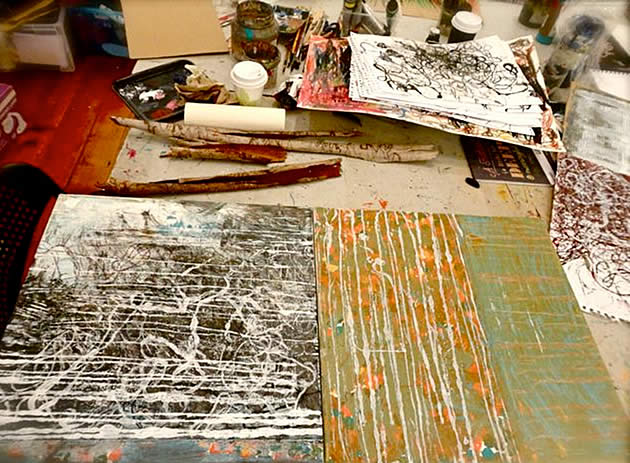
Paint with a mop
Sometimes a mere modify of scale can be enough to invigorate and inspire a pupil. While nigh students do non have access to enormous brushes like those used past contemporary painter Fabienne Verdier, there are plenty of other substitutes that might make do: old kitchen mops, brooms, branches off copse, big house paint brushes…

Make a drawing car
Cartoon machines come up in many shapes and forms. While nigh high schoolhouse Art students do not have the time to create circuitous, automated drawing devices (such as the ones illustrated below), the concept of mechanical application can be used to inspire creative output on a smaller calibration.
A drawing machine past Eske Rex:
A drawing machine by Joseph Griffiths:
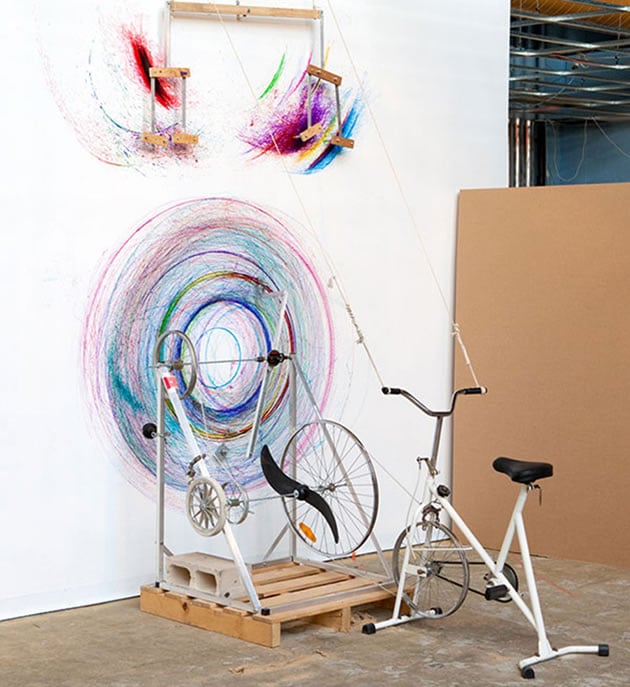
Penwald drawings pastTony Orrico:

Pigment using anarchistic mediums
Although care needs to be taken when using materials that are not purpose built for art-making (especially when posting artwork to some other state for assessment), avoiding sticky mediums that do not dry cleanly, or those which decay / rot over time, in that location are plenty of exciting, unusual products that can be used, which are found outside of the fine art supplies closet. Dye from walnut skins, stains from coffee cups, brightly coloured nutrient dyes, splashes of shellac (varnish) and so on, can create wonderful outcomes.
Painting with M&Ms by Nikau Hindin:

Sprinkle watercolours with alcohol or common salt
Artists take long known that sure chemicals resist wet paint and tin can be used to create textural surface patterns. Sprinkle semi-wet washes of watercolour with alcohol, common salt, dishwashing soap or bleach etc, and the outcome volition be an organic, intricate pattern.
Instance of table salt sprinkled onto watercolours past Sarah Knight:

Press foodwrap into watercolours
As with the technique above, pressing crinkled plastic foodwrap (such equally Gladwrap) into wet watercolours results in intriguing patterns once the plastic is peeled off when dry.
Case by artist John Burge:
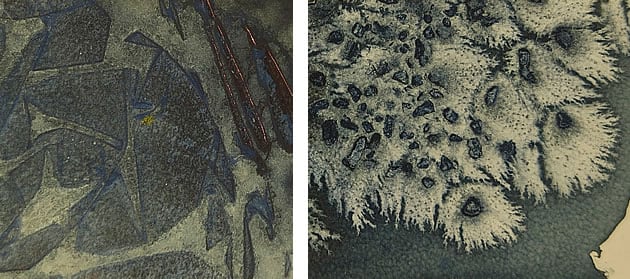
Apply gel medium to create digital transfers
Although students should be conscientious not to rely on digital transfers at the expense of their own observational drawing, there are times when the integration of digital elements in traditional paintings can have spectacular outcomes. The following video by Chrystal Hethcote shows a elementary image transfer technique using gel medium, which could exist useful for applying a digital image to a traditional painting surface:
Spray paint through holes to create texture or patterns
Painting students frequently forget that stencils offering heady possibilities. Items with gaps or holes can act as a stencil through which paint can be sprayed or flicked, creating repeating patterns, textures or irregular marks. Any number of constitute objects (leaves, branches, feathers, lace, mesh, material) or purposefully created items (card templates or paper with holes cut or ripped through it) can exist suitable. It is non necessary to purchase large cans of industrial spray paint for this (indeed these tin can exist hard to wield and tend to fill a classroom with pigment fumes); rather apply small-scale, empty spray bottles from craft shops and fill these with watered down acrylic in appropriate colours.
Application of spray pigment through lace by Tara Nelson:

Foliage prints by Diamara:

Card stencils past Julie Fei-Fan Balzer:
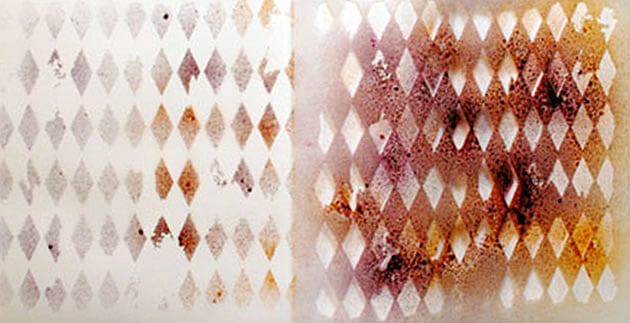
Intricate paper stencils by Kris Trappeniers:
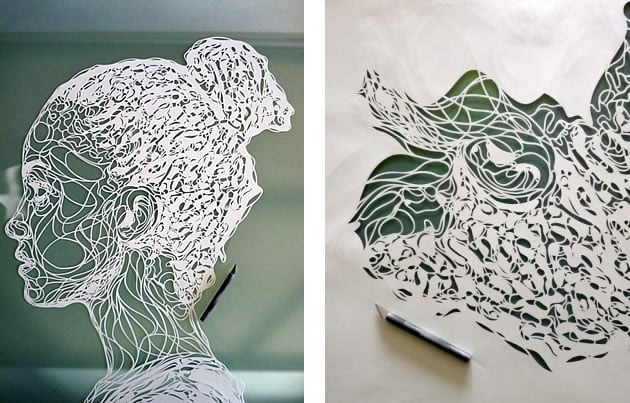
Apply ink directly to objects and print them
At that place are many natural forms (i.e. leaves, fish, mushrooms, eroding sticks) and manmade materials (i.east. corrugated cardboard) which tin act as printable objects themselves. While objects should only be used if they support your theme or subject, this can be an heady method for introducing textural elements to painted artworks.
Gyotaku fish prints by Barry Singer:

Mushroom spore print past Lynn Corsi Bland:

Corrugated paper-thin relief print by Christina Leung:

Print from a rotated termite eaten stick by Christina Leung:

Make items to print from
If you lot are unable to find suitable items to print, make some. From drizzling hot mucilage to layering strips of cardboard, there are endless ways to create abstract design making that can provide interesting mark-making within (or under) a painting. Remember not to make random patterns for the sake of it: select shapes and forms that back up the ideas explored within your work.
A hot mucilage print by Terri Stegmiller:
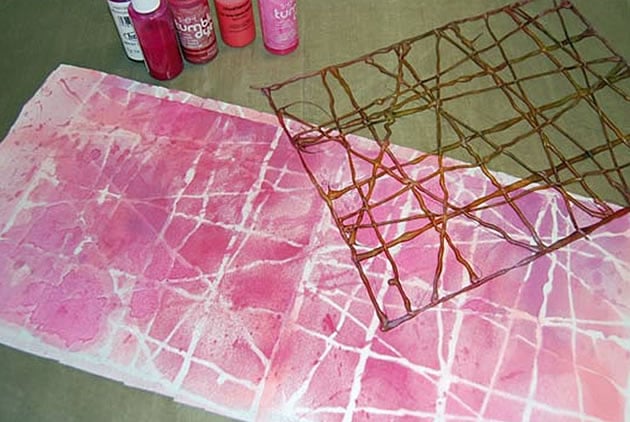
Printed blueprint by Susan Mathews:

Accept rubbings / employ frottage to add texture
A 'rubbing' is the act of laying a piece of paper over a textured item and rubbing a pencil or crayon (or some other medium) over the meridian to make an impression of that texture on the newspaper. The frottage art technique simply involves taking a rubbing one pace further, and using information technology to create an artwork that no longer direct mimics the original form. Although information technology can be hard to add frottage to paintings (unless as pencil under-drawings), using frottage can quickly upshot in interesting and varied drawings.
Frottage art by Kumi Yamashita:
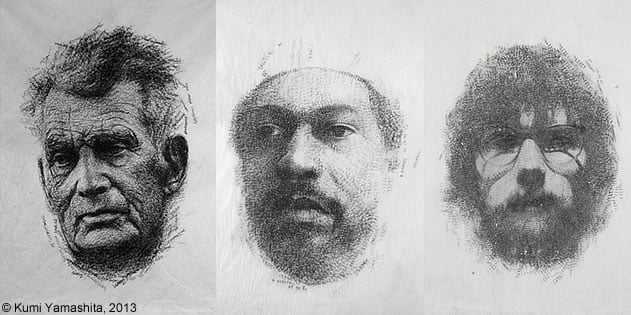
Frottage art by Max Ernst:

Paint with any other random thing y'all tin find
When it comes to painting utensils and tools, you are express simply past your imagination. Kids' toys tin can be driven through paint; one-time shoes can exist used to create footprints; fly swats can whack gridded patterns across a slice of paper.
Although it is not always necessary to use paint in wild and unexpected ways, there are times when this can exhale fresh air into your project!
This is the tertiary commodity in a series aimed at encouraging inventive utilise of media for high school Painting / Art students. You may also exist interested in reading Part 1: How to make your Art Project Exciting and Office 2: Painting on Grounds. If you found this helpful, please share it with your followers using the social media buttons below.

Amiria has been an Art & Blueprint teacher and a Curriculum Co-ordinator for seven years, responsible for the class design and assessment of pupil work in two high-achieving Auckland schools. She has a Bachelor of Architectural Studies, Bachelor of Architecture (First Class Honours) and a Graduate Diploma of Teaching. Amiria is a CIE Accredited Art & Blueprint Coursework Assessor.
Source: https://www.studentartguide.com/articles/inventive-mixed-media-techniques
0 Response to "Beyond the Brush: Inventive Use of Media for Painting Students"
Post a Comment